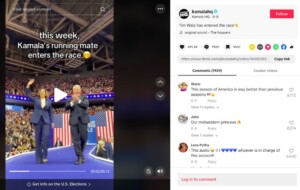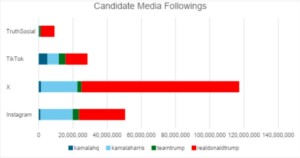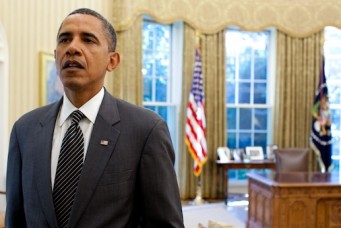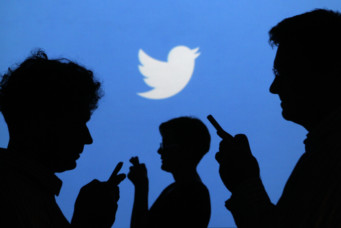Posting Our Way to the Presidency
American presidential campaigns have increasingly turned to social media to reach Gen Z voters. How well can they speak the youth’s language?

No longer is political campaigning restrained to newspaper articles or TV interviews. In the 2024 U.S. presidential race, social media platforms have swung open their doors to potential candidates, promising an effective channel to reach young Americans. Both the Harris and Trump campaigns have stepped over the threshold and into this new frontier of political advertising.
Both are keenly aware that “Gen Z”—a group that can be roughly defined by their age (teens to late twenties) and social media prowess—are a growing constituency. The most recent U.S. Census data from November 2022 notes that American citizens aged 18-24 numbered 26.7 million during the 2022 congressional midterms: about 11 percent of America’s 233.5 million-strong citizenry of voting age.
The data reports that, of these Gen-Z Americans, 45.6 percent reported being registered to vote, while 25.6 percent reported actually making it to the polls. Both figures fall far under the reported national rates of 63.2 and 47.7 percent, respectively. Gen Z thus presents a market that, if won over, could draw millions of popular votes to either candidate’s side.
The way to their hearts? Their screens. Users aged 18-29 are dialed into YouTube, Instagram, Snapchat, and TikTok, which are used by between 62-93 percent of the cohort. Pinterest, Reddit, and X (formerly Twitter) follow at 42-45 percent use rates. Meanwhile, according to a 2023 Pew survey, use rates of almost all social media applications decrease with age (Facebook, LinkedIn, and WhatsApp, which are most popular among users aged 30-49, are notable exceptions).
The age differentials among Instagram, TikTok, Snapchat, and X users are particularly high. On these applications, Gen Z outnumber users aged 30-49 by between 15-35 percentage points.
The Trump and Harris campaigns, the latter especially so, have dedicated significant resources to reaching the digital generation. In September 2024, the Wesleyan Media Project reported that the Harris campaign had spent $22.8 million advertising on Meta, the company that owns Facebook and Instagram, between September 9-21. The figure dwarfs the Trump campaign’s $1.4 million expenditure. But has all this investment secured Harris an advantage on socials?
Democratic Memes
The Harris campaign knows two things: first, Gen Z is necessary to win the presidency. Second, it’s a “brat summer”.
That the Harris campaign would focus heavily on social media became clear even before Harris replaced Joe Biden as the presumptive Democratic nominee on July 21. The summer months doused social media in lime green and Arial, a nod to the cover art of singer Charli XCX’s wildly popular June album titled simply: “brat”. Since the album’s release, social media teams across the world have adopted the format to promote their products.
@KamalaHQ, the Harris campaign’s official account, adapted the trend by posting “google project 2025” on TikTok in the same style. “Project 2025” refers to the roadmap for a conservative presidency published by the Heritage Foundation and other conservative organizations in 2023. Trump has repeatedly stated that he does not endorse the plan—which includes such priorities as mass deportations and the elimination of the Department of Education—though several politicians affiliated with the Trump administration contributed to the report. Kamala’s social media team has taken advantage of this marketing trend to bring the youth’s attention to this political movement which many liberals consider extremely concerning.
Harris’ popularity amongst this audience was secured when Charli posted to her 3.7 million followers on X that “kamala IS brat” the day of her de facto coronation as Biden’s replacement. But, what is “brat”?
For those outside of the TikTok bubble, the messages sometimes require translation. An NBC segment “Breaking down the meaning of ‘brat’ with Vice President Kamala Harris” attempts to explain it for Gen-X and up. “‘Brat’ or ‘a brat?’” asked the anchor to introduce the segment. The reporter replied that the “people I talk to [are] describing the word brat as embracing your imperfections and being your authentic self.”
For Gen Z’ers, the beauty of callbacks like “brat” is that they require no clarification. No mental gymnastics. For them, anyone who is anyone is listening to Charli XCX. When a candidate makes a reference to her album, they show not only that they notice the youth, but that they speak the same language as well.
The Democratic foray onto TikTok is recent. Harris created her first personal account on the platform this summer. “Well, I’ve heard that recently I’ve been on the for-you page, so I thought it was time to join myself,” said Harris in her first TikTok, posted on July 25.
The official Kamala HQ account has outpaced Harris’ personal account, @KamalaHarris, as lead poster across platforms. Kamala HQ posts oscillate between polished interview clips and niche cultural references. It isn’t just popular albums, either; references run the gamut of any popular trend, especially from television. Shortly after Minnesota Governor Tim Walz was announced as Harris’ running mate, viewers saw a video of the pair overlaid with the massively popular reality show Love Island’s iconic narration: “This week, a hot new bombshell enters the villa.”

Why does the Harris campaign jump on every emerging trend? It has to do with social media algorithms. The algorithm decides which videos are pushed to which viewer’s feed; the factors that influence this placement include the audio used in the video, the hashtags added in the caption, the time other viewers spent watching the video, and the amount of likes and comments on the clip. The sound bite from Love Island has been used on TikTok over 30,000 times. Every viewer that had liked or commented on a previous video using the same audio is more likely to receive the Harris video on their feed as a result. Following a trend is a safe bet to increase the amount of eyes on any piece of campaign media.
Copying exact trends isn’t the only way to engage with a young audience, however. Appealing to the youth’s sense of humor is another tried and true method. Walz, who created his first account on TikTok shortly after he was announced as Harris’ running mate, cracked a dad joke in his first video, celebrating his entry onto “TimTok” (a play on his first name) on August 16. Standing with his dog next to a river and dressed in a t-shirt and khakis, Walz leaned into his image of a friendly neighborhood dad, an approachable and relatable brand for the younger generation.
The angle is clear. In a post titled her “message to Gen Z” on September 18, Harris says: “You are one of the reasons I am so optimistic and excited about the future of our country.”
Harris wants the young vote: and, by playing into social media trends, her campaign has signaled a willingness to meet Gen Z’ers on their turf. Is Trump doing the same?
Raw Republicanism
The Trump campaign is no stranger to the digital world: Trump himself is famous for posting without filter on his personal X account, @RealDonaldTrump before, during, and after his presidency. Trump’s posts on X follow a distinct style, often using grammatically-unnecessary capitalization and exclamation marks for emphasis and utilizing disparaging nicknames for Trump’s political opponents, such as “Lyin’ Kamala.”
While Harris uses trends to connect to social media users, Trump uses plain language. His bombastic style of writing gives his posts an unfiltered feel, causing users to feel that they’re hearing from Trump himself, as opposed to a social media team.
However, there are consequences for Trump’s unfiltered strategy. In 2021, Twitter banned both @RealDonaldTrump and @TeamTrump from its platform indefinitely because of the January 6 insurrection. After he lost the election and his supporters stormed the Capitol Building, Twitter stated that Trump’s posts had amounted to “incitement of violence”. Trump returned to the platform in 2023 after it was purchased by tech and space mogul Elon Musk (who has since endorsed Trump) and rebranded the platform as X.
During his exile from Twitter, Trump began his own social media network, Truth Social. The platform was created in 2022 as a direct response to the Twitter content moderation strategy, which Trump accused of being too liberal, particularly after it resulted in his expulsion. In its Community Guidelines, Truth Social brands itself as a “‘big tent’ of ideas” that operates “in the spirit of the First Amendment to the United States Constitution.” The Guidelines explicitly write: “Our preference is that the removal of users or user-provided content be kept to the absolute minimum. Our preference is to leave choices regarding what is seen and who is heard to each individual person.” Even Kamala HQ has created a Truth Social account, which has 425,000 followers as of November 2 (less than its 5.1 million on TikTok, 1.4 million on X, and 1.1 million on Instagram).
Beyond Truth Social, the former president has also ventured into TikTok. He chose to mark his entry to the platform with Dana White, the CEO of Ultimate Fighting Championship (UFC), at UFC’s June 1, 2024 match between Islam Makhachev and Dustin Poirier. UFC, which is generally more popular among conservative audiences, offered a perfect introduction for Trump to his right-leaning target audience.

Trump is targeting young voters within the conservative crowd, particularly by collaborating with popular social media influencers. In a July 27 video, for instance, the Trump account reposted and responded to a video of Harris seemingly calling voters between the ages of 18-24 stupid. A fact-check by Reuters published on July 26, 2024—prior to Trump’s TikTok—states that the clip, which had already been circulated as a snippet on social media, had been “cropped and stripped of its context.” Nonetheless, Trump took the video at face value and collaborated with well-known TikToker-turned-boxer, Jake Paul, to make a video about it.
“She’s not the brightest bulb in the ceiling,” Trump says of Harris as he stands next to Paul. “She’s not that smart,” the twenty-seven-year-old concurs. What is the benefit of including Paul in the post? Similar to Harris invoking Charli XCX, Trump acquires a wider, younger audience by bringing in Paul. Having become social-media famous in 2016, Paul’s TikTok now boasts 18 million followers and he is one of several popular male Tik Tokers who have endorsed Donald Trump. Trump’s inclusion of Paul and UFC fosters a culture of masculinity, which is heightened by the pair’s disparaging remarks on Harris.
Trump’s choice in handle, “RealDonaldTrump”, speaks to his campaigning approach. When people follow Donald Trump on social media, for better or worse, they feel as though they get to see him: raw, unfiltered, and (at first glance) without the social media prowess of several Gen Z interns. Harris’ strategy, by contrast, is by-the-book: a means to place the polished candidate and the memes that follow her side by side, but far enough to separate if needed. Trump’s strategy works for him. Across platforms, @RealDonaldTrump maintains more followers than @KamalaHQ and @KamalaHarris combined. But how will this social media presence translate in the polls?

Who’s winning?
Among those registered, Gen Z voters tend to sway progressive. Data from Harvard University’s annual Youth Poll, run between September 4-16, shows that Harris leads Trump by 31 percentage points among voters aged 18-29 who are planning to participate in the general election. Harris’ lead is due in part to an “enthusiasm gap” wherein Democratic Gen Z-ers are 14 percentage points more likely to vote than their Republican counterparts.
In addition to age, gender is also playing a critical role. Claire Cain Miller writes for the New York Times that the 2024 presidential election will serve as “a referendum on gender roles.” Miller points to New York Times/Siena College polling data that shows that Trump led by 13 percentage points among men aged 18-29 in August. Alternatively, Harris led among women of the same age by 38 percentage points. Harvard’s Youth Poll emphasizes the gender gap even further, noting that up to 70 percent of Gen-Z women are likely to vote for Harris over Trump.
Yet, there’s a large contingent of Gen Z that is disillusioned with both candidates. A Gallup poll conducted between April-May of 2024 shows that 51 percent of Americans aged 12-27 reported having “very little trust” in the presidency (just over Gallup’s population average of 46 percent).
These conclusions are echoed by the Youth Poll. Over 30 percent of Youth Poll respondents noted—prior to Harris’ ascension to the ticket—that they trusted neither Biden nor Trump on a number of key issues, including protecting democracy, abortion, healthcare, and gun violence.
Forty-four percent of respondents indicated that they trusted neither candidate on the Israel-Hamas war—the highest proportion seen on any issue assessed. Indeed, more than 500,000 Americans voted “uncommitted” in the spring primary elections as part of the “Uncommitted Movement,” composing 13 percent of the vote in Michigan and up to 29 percent of the vote in Hawaii.
The movement directly targeted Biden’s prospects for re-election, highlighting some Democratic voters’ dissatisfaction with his support for Israeli war efforts. The effect has trickled down to Harris: 29 percent of respondents indicated trusting Trump on the issue, edging past the 26 percent who trust Harris.
Trump does not enjoy unanimous support from young Republicans, either. In an opinion piece for USA Today, conservative columnist Dace Potas speaks as part of a cohort for whom Harris is too liberal and Trump is undemocratic. “Nobody from Gen Z has had the chance to vote for a Republican presidential nominee besides Trump, a fact that is particularly frustrating for young, small government conservatives like me,” Potas writes. To him, it is incumbent on young Republicans to “build a new generation of Reagan conservatives”.
Critically, the Youth Poll also shows that social media has positively impacted perceptions of Harris. Over 50 percent of Gen Z-ers report encountering memes—presumably both organic and campaign-manufactured—of both Harris and Trump in the month prior to polling. 31 percent of respondents report being “positively influenced” by memes centering Harris, while 13 percent say the same of Trump.
We thus see a tale of two sets of data. Polling statistics indicate that the Harris social media strategy has been effective in positively influencing perceptions of the campaign, and that more registered Gen Z’ers plan to vote blue. However, follower counts indicate that Trump has succeeded in amassing a behemoth digital following across platforms that has captured the hearts and minds of many young men.
Yet, both campaign strategies have visible flaws. Aspects of each candidate’s platform—including the Israel-Palestine conflict on Harris’ end and the 2021 insurrection on Trump’s—have polarized young voters, and in some cases pushed them away. Moreover, the deep-seated mistrust present amongst Gen Z toward the presidency indicates that they won’t be easily won over. The November 5 general election is tomorrow. Ultimately, only time will tell the outcome; but, data-driven impact thus far makes clear that election advertising will never retreat from the digital frontier.












